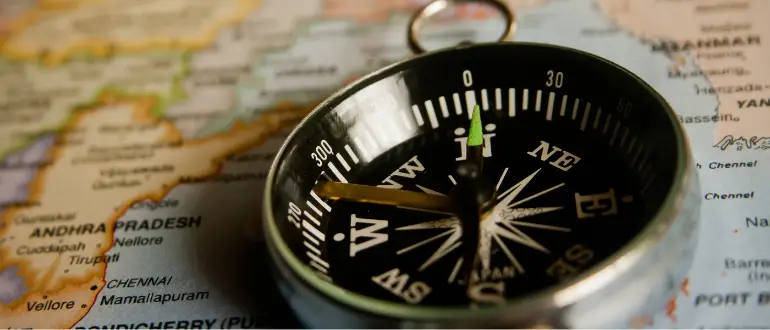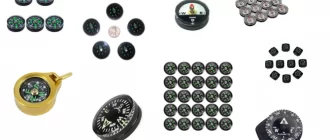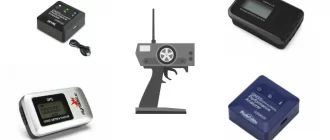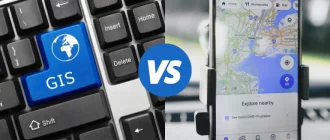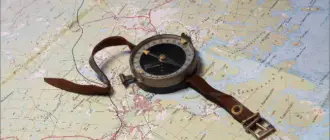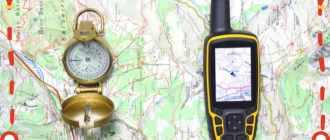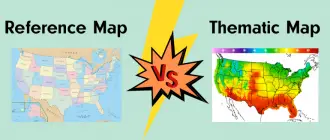Since I was a young child, I have been a huge fan of compasses. I have always had the question in my mind of why does a compass point north. However, I would push it to the side and not think much else about it.
One day, I could not get this question out of my mind, so I decided to do some research to find out the answer as quickly and clearly as possible. Immediately, I became surprised to learn that I was not alone in wondering this question and decided to help answer it for others who have this deep curiosity about these devices as well.
just gifted a compass that doesn’t point north … pic.twitter.com/Wd6IE5sjj7
— j4ck.eth (😈,😇) • ◐ SZNS.io (@Jack_Dille) November 24, 2021
I was also stunned to learn that when this gadget’s needle points north it is actually because it is attracted to the south magnetic pole. If this sounds confusing, that is expected. I will elaborate more on this throughout the article to make it easier to understand.
In this article, you will officially know:
- Why a compass points north →
- What a compass is →
- How this device works →
- The difference between the magnetic north and geographic north →
- The answer to if all magnets have a north and south pole →
- And what can affect the magnetic needle in this device →
Why Does a Compass Point North?
I want to start with the fact that when you are using a compass, you are actually using a magnet. This may sound absurd, but it is very true. That is right; the small pointer that moves is a tiny magnet. The needle points to a specific direction because the planet has magnetism, which means it acts like a magnet as well.
One magnet’s north pole is attracted to another magnet’s south pole because opposites attract. Therefore, Earth’s south magnetic pole is actually up north, which may be surprising. The planet’s south pole is near its geographic north, while the planet’s north pole is near the planet’s geographic south. As a result, the north pole in a compass points north because this is where Earth’s south magnetic pole is located.
It is a True Fact that like a compass, all cats point north. pic.twitter.com/MUBdqFwry6
— Will Redman (@TheSnoodles) November 24, 2021
After answering why does a compass point north, we should back up and learn what these special gadgets are and how they work, which I will answer next.
What Is a Compass?
A compass is a special device that tells you the direction. It is one of the most important tools used for navigating different areas. Magnetic compasses are the most popular types of these devices.
In fact, when someone is talking about these products, they are most likely always referring to the magnetic types. The design and making of these gadgets have changed over time, but the entire concept of how this object works is still the same as it was centuries ago.
To find out more about how these devices came about and changed the world, watch TED’s YouTube video. In this video, David Biello goes over how compasses changed humans’ relationship with the world. I believe you will find this short video very interesting and informative.
If you like these incredible instruments and want to add more to your collection, I also recommend taking a look at wrist compasses. It is very easy to lose these small devices, but by having one connected to your wrist at all times will decrease your chances as well as reduce your worries. If you would like to learn more about these types of devices, I have written an article on the best wrist compasses. In this article, I will tell you all about these devices as well as helping you select the perfect one.
How Does a Compass Work?
It is very interesting to think about how these tools work. According to Universe Today, these neat devices work by finding the Earth’s magnetic fields. The Earth has a core that is half liquid and half solid because of the pressure from gravity. Scientists believe that the movement in the liquid outer core is what creates the Earth’s magnetic field.
Therefore, the planet’s magnetic field has two main poles, which are the north and south pole. These poles are a little off from the Earth’s axis rotation. However, they are still close enough that the directions can be used to help people find their way around.
If you are interested in learning more about how these devices work, check out STOKERMATIC’s YouTube video. This video explains the various elements that this instrument consists of as well as how to correctly use one. The video uses a military compass, but it will still be beneficial to you no matter which type of device you choose.
As someone who was once confused about the difference of GIS and GPS, it is understandable if you are as well. For more information on GIS vs GPS, head over to my other article that explains the difference between these two important systems here.
Magnetic North Vs Geographic North
There is a big difference between the Magnetic North and the Geographic North. As a matter of fact, the Magnetic North Pole is currently a point on Ellesmere Island in Northern Canada. When you begin using a compass, it will automatically align with the Magnetic North because it is associated with the planet’s magnetism.
The Geographic North Pole, commonly referred to as the True North, is part of where the lines of longitude meet in the north. The Geographic North Pole can be found in the center of the Arctic Ocean. However, scientists are unable to accurately mark this area, as it is covered in moving ice.
In simple terms, the Geographic North Pole is an area on Earth where the axis meets the surface, whereas the Magnetic North is where the planet’s magnetic field points downward. The Magnetic North is continuously changing with Earth’s magnetic field, while the Geographic North remains the same.
A video that I found helpful in explaining the True North vs Magnetic North is ScienceOnline’s YouTube video. This video will guide you in understanding the origins of directions, such as North, South, East, and West. Although it is a nine-minute video, it provides a lot of neat information.
Now, I will tell you if all magnets have a north and south pole.
Do All Magnets Have a North and South Pole?
All magnets do have a north and south pole. Interestingly, the opposite poles are attracted to one another as well as deter from one another. Whenever you take a piece of iron and rub it against a magnet, the north-seeking particles in the iron will all align in the same direction. This force created by the atoms develops a magnetic field. Therefore, the iron has formed into a magnet.
If you would like to see an image of a very old compass dating back to the 16th Century, Archeo – Histories @archeohistories tweeted an awesome picture of one.
Diptych ivory sundial with compass for latitude 49° North, 1650-1700. Charles Bloud, Dieppe France.
This octagonal ivory dial consists of two leaves that fold together when not in use.#archaeohistories pic.twitter.com/IxwO2n5qWT
— Archaeo – Histories (@archeohistories) November 22, 2021
An interesting feature on this old device is that the two leaves fold together when no one is using it.
What Can Affect the Magnetic Needle in a Compass?
It is important to know that all types of metal objects can affect a magnetic needle in a compass. Some of these items include knives, belt buckles, gun barrels, jewelry, keys, and more. You should try to keep your device away from metal objects, as they can give you a false reading. To ensure that your gadget remains accurate, make sure that there is nothing metal close by to this device the entire time you are using it.
Another video by STOKERMATIC that I recommend taking a look at is his YouTube video discussing how to use a compass without a map. This is a longer video, but it goes into detail about successfully using this product without a map. He will share all his knowledge on how to get from one point to another and all the way back by solely using this handy device with no map in sight.
My advice is to watch this video in case you ever find yourself in this type of situation or if you just have a passion for exploring.
If you find yourself wanting to know more, I suggest taking your learning to a new level by earning a GIS certificate. I have written an article about 15 best GIS certificate online programs, which you can find here. The courses are centered around maps, compasses, data, and the Earth.
Useful Resources
My Overall Thoughts
I hope that this article helps answer your question as to why does a compass point north. This is a commonly asked question, which I was once curious about as well. Therefore, I hope that I explained it well and made it more understandable for you.
These devices are amazing little products that I recommend everyone trying at least once, especially if you are a person that is interested in the outdoors or participating in outdoor activities, such as hiking, biking, mountain climbing, hunting, ATVing, and more. It may take you some time to get accustomed to this new tool, but I guarantee that you will never want to leave home without it once you get used to it.

